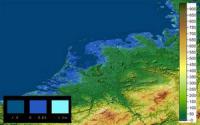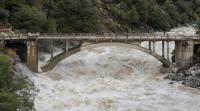-
2017 saw the highest ever sea level on the Dutch coast

The average sea level measured on the Dutch coast was higher than ever before in 2017. The Dutch sea level, the averaged measurements from six tide stations, rose to 11 cm above Normal Amsterdam Water Level (NAP in Dutch). The last highest measurement was in 2007, when the average sea level was 9 cm above NAP. The fact that the sea level was higher last year does not mean that the sea level is now rising faster. At present, the sea level on the Dutch coast is rising by 20 cm every century.
-
-
River flood risks increase around the globe under future warming

Rainfall changes caused by global warming will increase river flood risks across the globe. Already today, fluvial floods are among the most common and devastating natural disasters. Scientists have now calculated the required increase in flood protection until the 2040s worldwide, breaking it down to single regions and cities. They find that the need for adaptation is greatest in the United States, parts of India and Africa, Indonesia, and in Central Europe including Germany. Inaction would expose many millions of people to severe flooding.
-
-
Climate change changing Earth’s landscape

Climate change will replace land use change as the major driver of changes in Earth’s biosphere in the twenty-first century if greenhouse gas emissions aren’t curbed, new research suggests. Historically, human land use change, like urban development and agricultural expansion, has been the primary cause of anthropogenic ecosystem change. But now, due to rising greenhouse gas levels, climate change has become a growing threat to ecosystems. The rapid pace of climate change is making it difficult for species to adapt to changes in temperature, water cycles, and other environmental conditions that affect life on Earth.
-
-
Rejection of subsidies for coal and nuclear power is a win for fact-based policymaking
Energy Secretary Rick Perry has repeatedly expressed concern over the past year about the reliability of our national electric power grid. On 28 September 2017, Perry ordered the Federal Energy Regulatory Commission (FERC) to revise wholesale electricity market rules, implicitly suggesting that the federal government would give subsidies to owners of coal and nuclear power plants, to compensate them for keeping a 90-day fuel supply on-site in the event of a disruption to the grid. On Monday, the independent five-member commission – four of whose members have been appointed by President Trump — unanimously rejected Perry’s proposal. FERC’s 5-0 decision shows that policymaking based on evidence won the day. Perry’s proposal, which critics said was aiming to prop up nuclear and coal power plants struggling in competitive electricity markets, had the potential to affect millions of electricity customers, as well as power markets and the environment. FERC deserves congratulations for putting evidence before action.
-
-
2017 climate, weather disasters in U.S. totaling $306 billion — a new record
2017 will be remembered as a year of extremes for the United States as floods, tornadoes, hurricanes, drought, fires, and freezes claimed hundreds of lives and visited economic hardship upon the nation. The average U.S. temperature in 2017 was 54.6 degrees F (2.6 degrees F above average), making 2017 third warmest year in 123 years of record-keeping. The five warmest years on record for the United States all have occurred since 2006. In 2017, the United States experienced 16 weather and climate disasters each with losses exceeding $1 billion, totaling approximately $306 billion — a new U.S. record. Far more tragic was the human toll. At least 362 people died and many more were injured during the course of these disasters.
-
-
Studying climate effects on California water systems from headwaters to groundwater
To address future climate change effects on water resources, scientists at five UC campuses, and Lawrence Livermore and Lawrence Berkeley national laboratories, will study California’s water systems, from the headwaters in the Sierra Nevada, through rivers, reservoirs and groundwater in the Central Valley. The project will allow scientists to examine hydrologic sensitivities of California headwaters and agricultural demand to changing climate and will consider plausible societal adaptations.
-
-
With storms intensifying and oceans on the rise, Boston weighs strategies for staying dry
As this year’s hurricanes marched across the Caribbean into the Gulf Coast or out to the North Atlantic, cities along the U.S. northeastern coast knew they were dodging bullets. If Boston gets hit by a storm like Hurricane Harvey, mayor Marty Walsh acknowledged in a radio interview, “we are wiped out as a city.” An MIT analysis suggests that a Category 1 hurricane with a few feet of surge on top of a high tide could flood a quarter of a million Boston residents. And climate change is bringing more intense storms and rising tides. A multi-billion-dollar seawall is among climate adaptation options under consideration for the iconic coastal city.
-
-
Geopolitical risks to U.S. oil supply lowest since the early 1970s
The geopolitical risks to the U.S. oil supply are the lowest since the early 1970s, due to fracking, climate action and a more diverse global supply, according to a new study. America’s energy prosperity contrasts with a more fraught period for energy-exporting countries where geopolitical challenges have been compounded by fiscal stress and rising domestic energy demand, the authors said.
-
-
New principles to guide corporate investment toward climate goals
Faced with climate change today, companies and investors face many complex ethical questions. Should investors continue to invest in fossil fuels or should they divest, sending a signal about the perceived illegitimacy of particular business models in a changing climate? Further, given the internationally agreed aspirations towards achieving net-zero emissions, how should investors manage the legal and financial risks of this transition?
-
-
Predicting the effect of climate change on crop yields
Scientists now have a new tool to predict the future effects of climate change on crop yields. Researchers are attempting to bridge two types of computational crop models to become more reliable predictors of crop production in the U.S. Corn Belt. “One class of crop models is agronomy-based and the other is embedded in climate models or earth system models. They are developed for different purposes and applied at different scales,” says the principal investigator on the research. “Because each has its own strengths and weaknesses, our simple idea is to combine the strengths of both types of models to make a new crop model with improved prediction performance.”
-
-
The Texas coastline is slowly disappearing. Here's how one community is coping.
The Lone Star State’s shoreline is experiencing one of the highest rates of land loss of any coastal area in the country thanks to a combination of subsidence, sea level rise, and storm surges. The significant land loss averages 4 feet per year along the state’s coastline, according to the Texas General Land Office. In some places, more than 30 feet of shoreline disappears underwater annually.
-
-
An X-factor in coastal flooding: Natural climate patterns create hot spots of rapid sea level rise
Many scientists have found evidence that climate change is amplifying the impacts of hurricanes. For example, several studies just published this month conclude that human-induced climate change made rainfall during Hurricane Harvey more intense. But climate change is not the only factor making hurricanes more damaging. A recent study showed that two converging natural climate processes created a “hot spot” from Cape Hatteras, North Carolina to Miami where sea levels rose six times faster than the global average between 2011 and 2015. We also showed that such hot spots have occurred at other points along the Eastern Seaboard over the past century. Now we see indications that one is developing in Texas and Louisiana, where it likely amplified flooding during Harvey – and could make future coastal storms more damaging. Accelerations in sea level rise are hard to predict, and it is unclear whether they will become more serious over time. But they make it even more urgent for coastal communities to take sea level rise seriously today.
-
-
Humidity may intensify heat stress to a point exceeding human endurance
Climate scientists say that killer heat waves will become increasingly prevalent in many regions as climate warms. However, most projections leave out a major factor that could worsen things: humidity, which can greatly magnify the effects of heat alone. Now, a new global study projects that in coming decades the effects of high humidity in many areas will dramatically increase. At times, they may surpass humans’ ability to work or, in some cases, even survive.
-
-
Hotter temperatures will accelerate asylum-seekers migration to Europe
New research predicts that migrants applying for asylum in the European Union will nearly triple over the average of the last fifteen years by 2100 if carbon emissions continue on their current path. The study suggests that cutting emissions could partially stem the tide, but even under an optimistic scenario, Europe could see asylum applications rise by at least a quarter.
-
-
Billion-dollar weather and climate disasters on the rise
from 1980 to 2017, the United States has sustained 218 weather and climate disasters in which overall damages/costs reached or exceeded $1 billion (including CPI adjustment to 2017). The total cost of these 218 events exceeds $1.2 trillion. This total does not yet include the costs for Hurricanes Harvey, Irma and Maria. Between 1 January and 6 October 2017, there have been fifteen weather and climate disaster events with losses exceeding $1 billion each across the United States. The 1980–2016 annual average pf weather events with losses exceeding $1 billion each is 5.5 events (CPI-adjusted); the annual average for the most recent 5 years (2012–2016) is 10.6 events (CPI-adjusted).
-
- All
- Regional
- Water
- Biometrics
- Borders/Immig
- Business
- Cybersecurity
- Detection
- Disasters
- Government
- Infrastructure
- International
- Public health
- Public Safety
- Communication interoperabillity
- Emergency services
- Emergency medical services
- Fire
- First response
- IEDs
- Law Enforcement
- Law Enforcement Technology
- Military technology
- Nonlethal weapons
- Nuclear weapons
- Personal protection equipment
- Police
- Notification /alert systems
- Situational awareness
- Weapons systems
- Sci-Tech
- Sector Reports
- Surveillance
- Transportation
Advertising & Marketing: advertise@newswirepubs.com
Editorial: editor@newswirepubs.com
General: info@newswirepubs.com
2010-2011 © News Wire Publications, LLC News Wire Publications, LLC
220 Old Country Road | Suite 200 | Mineola | New York | 11501
Permissions and Policies
Editorial: editor@newswirepubs.com
General: info@newswirepubs.com
2010-2011 © News Wire Publications, LLC News Wire Publications, LLC
220 Old Country Road | Suite 200 | Mineola | New York | 11501
Permissions and Policies
